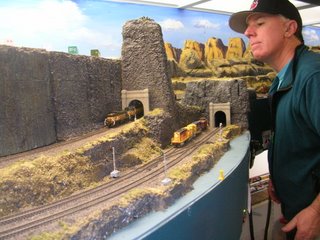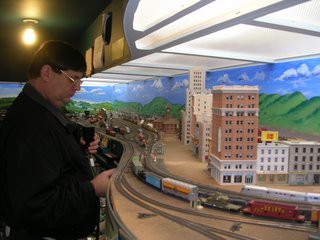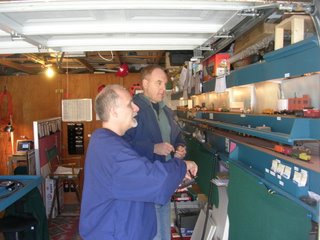Jim (who came from Seattle area) works the westyard switcher while Portland Yardmaster Andy (from Bay Area) works the east end
Then there are the "non-serious" fun loving playful crew members... had to kick them out around 5 PM...
The OWNRy, as it is called, is a fictional protolanced railroad set in the Pacfic Northwest during pre-merger, Pre Amtrak days loosely meaning around 1971 or so. N is the scale of choice. The main division point is Portland, OR, and I have 3 yards and 4 staging yards. I hold regular operating sessions.


 Fortunately their experience in operating aided them in surviving. and after the first hour, as with most newbies to a layout (including yours truly), they were in the flow and trains were rolling even faster. Intrepid Dispatcher Jacobson figured out the JMRI dispatch panel (who better to do so?) and discovered the little gremlin causing problems then it was smooth sailing from there. All told we moved 28 trains including a couple of extra trains. THe only train not run was the Valley Flyer (RDC). Pasco, as usual, proved to be a fun experience, one John will definitely remember (Mark will pay later
Fortunately their experience in operating aided them in surviving. and after the first hour, as with most newbies to a layout (including yours truly), they were in the flow and trains were rolling even faster. Intrepid Dispatcher Jacobson figured out the JMRI dispatch panel (who better to do so?) and discovered the little gremlin causing problems then it was smooth sailing from there. All told we moved 28 trains including a couple of extra trains. THe only train not run was the Valley Flyer (RDC). Pasco, as usual, proved to be a fun experience, one John will definitely remember (Mark will pay later 


 Greg is moving an SP&S freight through the tunnel westbound to Portland from Pasco.
Greg is moving an SP&S freight through the tunnel westbound to Portland from Pasco. Mark, the Portland yardmaster switches a line of arrival on the West yard lead. Soon after, we lost the west end classification switches so he finished his work on the east end. Glad we had double ended yards.
Mark, the Portland yardmaster switches a line of arrival on the West yard lead. Soon after, we lost the west end classification switches so he finished his work on the east end. Glad we had double ended yards. Frank drives the Shasta Daylight across the Willamette River bridge northbound to Portland then on around the layout for a nice little tour.
Frank drives the Shasta Daylight across the Willamette River bridge northbound to Portland then on around the layout for a nice little tour. Tom works with Seattle yardmaster, Mitch, to set out and pick up cars. All trains stayed on the layout and most stayed on the tracks, too!!
Tom works with Seattle yardmaster, Mitch, to set out and pick up cars. All trains stayed on the layout and most stayed on the tracks, too!! Everyone looks busy in the main layout room. Portland yard is on the right and Pasco yard is on the right.
Everyone looks busy in the main layout room. Portland yard is on the right and Pasco yard is on the right.

 This is my test track (above) for both N scale (in which I model) and HO for my friends. It features a Digirax Zephyr command station. The circle of track has 16 equal length blocks each detected with a Digitrax BDL162 feeding back into the loconet, a programming track, Locobuffer which connects the loconet to the PC and Laptop with JMRI Decoder Pro installed.
This is my test track (above) for both N scale (in which I model) and HO for my friends. It features a Digirax Zephyr command station. The circle of track has 16 equal length blocks each detected with a Digitrax BDL162 feeding back into the loconet, a programming track, Locobuffer which connects the loconet to the PC and Laptop with JMRI Decoder Pro installed.